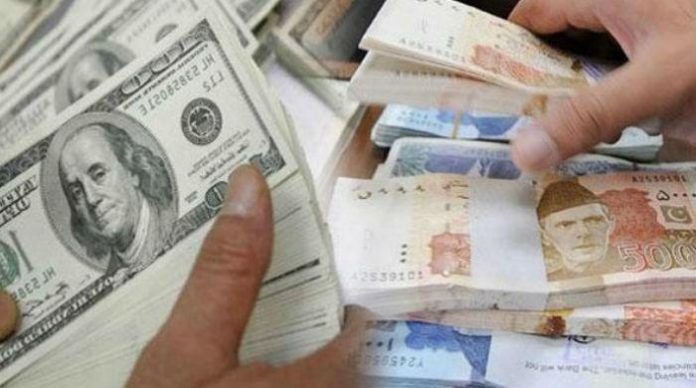The rupee declined sharply against the US dollar during intraday trading Wednesday and no explanation and little rationale has been provided by the central bank or the federal finance ministry so far. Though federal finance minister Ishaq Dar called a meeting of banking supremos to successfully arrest the steep decline, and retrieve the rupee quite substantively. The rupee had lost around 3.2% against the US dollar from the level of 104.85 (interbank) – a level that has remained unchanged by and large for more than two years – to 108.50.
Having worked in a treasury of a large local bank I have personally dealt the rupee in volatile conditions. On 26th September of 2013, for example, a similar incident took place. Like Wednesday the interbank market opened in a normal fashion but within hours the rupee went into a nosedive and by the end of the ready session (same day settlement) it had depreciated from 107.50 (opening rate) to around 111.50, which was the highest quoted rate in the market on that day.
In the second session, the same day, there was a major correction and the rupee appreciated swiftly to settle at a level of 105.50. There was panic and uncertainty in the market, and as is the wont in such cases, the central bank called up treasuries of banks and asked to initially halt all trading, L/C retirements and later to trade between a range.
A day later teams from State Bank of Pakistan (SBP) and Federal Investigation Authority (FIA) started visiting the offices of all treasuries to collect front and back office data of trades and deals from that fateful day. The reason for that volatility actually turned out to be multiple major payments (including a big one for an oil L/C and an IMF repayment) falling on the same day accompanied by mishandling by the central bank.
The latest case in point was much different and, to a trained eye, the rupee’s slide looks to be much more intentional than it seems. The level of 104.50 has been maintained, much to the ire of exporters, for more than two years now. It is Ishaq Dar’s ‘comfort zone’ that feeds his augmented sense of the country’s economic health.
According to a source in the finance ministry this was SBP’s way of sending a message to Dar who runs the central bank much like a business of his own. But realistically it is not possible for such major fall in the rupee’s value to come about without his blessing.
Dar dictates the central bank to intervene in the market through banks to manage the demand and supply of US dollar in order to keep the rupee/dollar parity range bound.
Here comes the rub. Political instability is causing this and it won’t cease unless this whole Panama and JIT issue is resolved. This narrative that the stock market and the currency market are taking a beating because the speculation is rife that the PM might be disqualified by the JIT is nonsense.
The demand and supply of dollars in the market is hardly influenced by what is happening in the political arena. A source from the central bank, speaking on condition of anonymity, said that Wednesday’s event was not a surprise and all relevant authorities (Read: Mr Dar) had signed off on the calculated move to refrain from any market intervention and let the rupee slide.
 According to SBP’s statement Thursday, the rate will be maintained between Rs105 and Rs107 against US dollar. The finance minister has said there will be a ‘comprehensive inquiry’ but that is all mere eyewash. The official line taken by the SBP is that this move was months in the making and had to be done to balance the external account. The finance ministry, however, calls the decline “artificial” that has negatively affected foreign exchange markets
According to SBP’s statement Thursday, the rate will be maintained between Rs105 and Rs107 against US dollar. The finance minister has said there will be a ‘comprehensive inquiry’ but that is all mere eyewash. The official line taken by the SBP is that this move was months in the making and had to be done to balance the external account. The finance ministry, however, calls the decline “artificial” that has negatively affected foreign exchange markets
This public spat was bound to happen. Contrary to the IMF’s recommendations no move has been made by the government to give independence to the central bank where the finance ministry has been exercising its control since the PML-N came to power. In the past, some crucial monetary policy statements like changes in the discount rate, for example, have been announced by Ishaq Dar much in advance of the SBP governor – something unheard of elsewhere in the world.
This incident highlights two very worrying aspects. One, that the rupee is overvalued and the real effective exchange rate (REER) is actually around Rs120, a concern that has been conveyed by the IMF innumerable times to the finance minister, only to fall on deaf ears. Two, the country’s economy is being run so shambolically that something as serious as the value of the rupee is played with so nonchalantly to gain political mileage.
But, in keeping with the general tendency in the incumbent government on most substantive issues, the entire thing is being played quite close to the chest, with little or no transparency, and crucial decisions pertaining but not limited to the economy are taken by the kitchen cabinet in Raiwand. The exchange rate must be quite low on the priority list to be discussed seriously, that too among people with little technical knowledge about it.
Dar doesn’t like seeing a weak rupee and has adopted the unsustainable model of intervening in the foreign exchange (FX) market with borrowed dollars (our FX Reserves). The pressure then keeps building and eventually either someone makes a miscalculation (2013) or a decision is taken at the top to not intervene altogether (Wednesday).
Such depreciation in the exchange rate might not make a big dent in the PM’s London vacation budget, but is surely a huge blow to small traders/importers who regularly open L/C’s and make budgets that allow for a reasonable movement in the exchange rate, which is certainly nowhere near Rs3.5 rupees in a few hours.
























